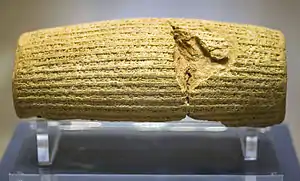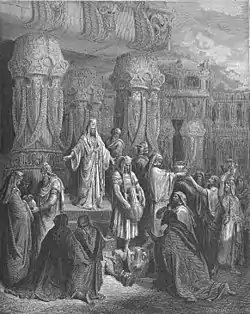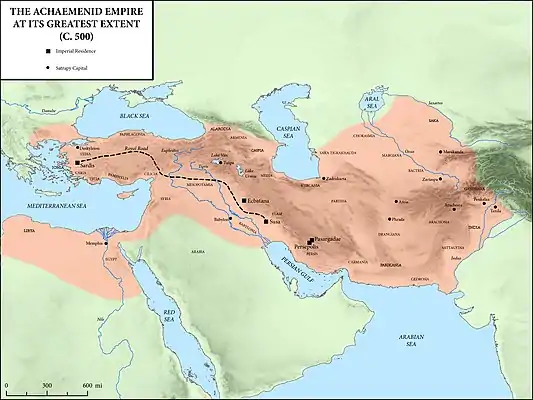Return to Zion
The return to Zion (Hebrew: שִׁיבָת צִיּוֹן, Shivat Tzion, or שבי ציון, Shavei Tzion, lit. Zion returnees) refers to the event in the biblical books of Ezra–Nehemiah in which the Jews returned to the Land of Israel from the Babylonian exile following the decree by the emperor Cyrus the Great, the conqueror of the Neo-Babylonian Empire in 539 BCE, also known as Cyrus's edict.
| Part of a series on |
| Aliyah |
|---|
 |
| Jewish return to the Land of Israel |
| Concepts |
| Pre-Modern Aliyah |
| Aliyah in modern times |
| Absorption |
| Organizations |
| Related topics |
The biblical meaning of the return to Zion, aliyah, was borrowed later from the ancient event and was adopted as the definition of all the immigration events of Jews to the Land of Israel and the State of Israel in modern times.
Babylonian exile
The Neo-Babylonian Empire under the rule of Nebuchadnezzar II occupied the Kingdom of Judah between 597–586 BCE. The Babylonian army, under the command of Nebuzaradan,[1] had destroyed the first temple in Jerusalem. According to the Hebrew Bible, the king of Judah, Zedekiah, was forced to watch his own two sons being slaughtered, and thereafter, his own eyes were put out and he was exiled to Babylon (2 Kings 25).[2] The population of the middle class and above was also deported alongside king Zedekiah, whereas the kingdom of Judah was left only with the poor ones. (2 Kings 24:14)
The deportees were led by Sheshbazzar, also named the prince of Judah, and Zerubbabel the son of Shealtiel, a descendant of King David. Sheshbazzar, who was probably Shenazzar the son of Jeconiah, king of Judah (1Chronicles 3:18), was picked by Cyrus to lead the deportees, but Zerubbabel was appointed shortly afterwards as a representative of the Achaemenid Empire in the Land of Israel (although some claim Zerubbabel and Sheshbazzar were the same person).
The return to Zion

According to the books of Ezra–Nehemiah, a number of decades later in 538 BCE, the Jews in Babylon were allowed to return to the Land of Israel, due to Cyrus's decree. Initially, around 50,000 Jews made aliyah to the land of Israel following the decree of Cyrus as described in Ezra, whereas most remained in Babylon.[3][4] Later, an unknown number of exiles returned from Babylon with Ezra himself.[5] The return of the deportees to Judah during the next 110 years is known as the return to Zion, an event by which Jews ever since have been inspired.[6]
Yehud Medinata
The returnees settled in what became known as Yehud Medinata or Yehud. Yehud Medinata was a self-governing Jewish province under the rule of the Achaemenid Empire which even issued their own Yehud coinage inscribed with the three letters Y-H-D.
The autonomy of Yehud Medinata inspired future generations of Jews, their notion of their own national identity and aspirations, the need to end 2000 years of exile since the Babylon captivity, and to continue to make aliyah to the Land of Israel. The ancient name Yehud Medinata also resembles the name of modern Hebrew name Medinat Yisrael (the State of Israel).
Biblical account
According to the books of Ezra–Nehemiah in the Hebrew Bible, the return to Zion occurred in several waves of aliyah.
Sheshbazzar's Aliyah

Sheshbazzar's aliyah (those claiming that Zerubbabel and Sheshbazzar were the same person, associate Sheshbazzar's aliyah with Zerubbabel's Aliyah), had occurred near after Cyrus's Decree, in 538 BCE. Approximately 1,000 young Jews made aliya in what became known as Sheshbazzar's Aliyah, out of the notion to redeem the land of Israel from its ruins and to re-establish the holy temple on the Temple Mount. This aliyah was named after its leader Sheshbazzar because most scholars have agreed that he is a descendant of the house of Jeconiah, king of Judah.
The Book of Ezra depicts Sheshbazzar's Aliyah as a consent and encouragement of the Persian King Cyrus:
7 And King Cyrus took out all the vessels of the House of the Lord, which Nebuchadnezzar had taken out of Jerusalem and had placed them in the temple of his god;
8 Now Cyrus, the king of Persia, took them out by the hand of Mithredath the treasurer, and he counted them out to Sheshbazzar, the prince of Judah…
11 All the vessels of silver and gold were five thousand, four hundred; Sheshbazzar brought up [ He'ela / Aliyah ] everything when the exiles were brought up [ He'alot / Aliyah ] from Babylon to Jerusalem.
— Book of Ezra 1:7–8,11 [7]
Zerubbabel's Aliyah
The second wave of aliyah, known as Zerubbabel's Aliyah, was led by Zerubbabel the son of Shealtiel, the grandson of Jeconiah, king of Judah, and a descendant of the house of David as well as Joshua the son of Jehozadak who was appointed as high priest (Kohen Gadol), in 538 BCE.
According to the account in the Book of Ezra, 42,360, not including servants or handmaids, made aliyah in this wave to Jerusalem and Judah. Among them, there were 24,144 ordinary men (57.12%) and 12,452 women and children (29.46%). There were also 4,289 priests (10.15%), 74 generic Levites (0.18%), 128 Singers (0.3%), 139 Gatekeepers (0.33%) (Singers and gatekeepers were specific roles of Levites in the holy temple in Jerusalem that had been passed from one generation to another), 392 Nethinim (0.93%), and 652 people who could not tell their fathers' houses and their ancestry (1.54%). 90 other people (0.21%) appear to have joined in, to complete that count of 42,360. In addition 7,337 servants and handmaids joined in, boosting the population to 49,697. They also brought up their working animals: 736 horses (one for about every 68 people), 246 mules (one for every 202 people), 435 camels (one per 114 people), and 6,720 donkeys (one for every 7 people).[8] A smaller portion of this wave of aliyah was well-born, possibly one-sixth of the returnees, whereas the rest were of a lower class and poor. The returnees in this aliyah were of the Tribe of Judah, Tribe of Levi and the Tribe of Benjamin, and settled in their cities and places from before the destruction of the first temple, Solomon's Temple, as many of them kept scribed documents indicating their land tenure status of land ownership in various places.
Due to the return of many single men, and the lack of Jewish single women, a phenomenon of mixed marriages with alien women developed. This wave of aliyah had been on good terms with the Persian government, which allowed them religious autonomy. However, the economic situation was not well – there was a lack of infrastructures due to the consecutive ruins in the aftermath of the destruction of the First Temple, taxes and many housing needs, as well as consecutive years of harsh drought and other natural disasters that hit the land of Israel. At those times the Jews reinstituted the sacrificial offerings to God with the re-establishment of the altar in 538 BCE (כ"ה בכסלו, שנת ג'רכ"ב). This event was prior to the reconstruction of the newly emerging temple in Jerusalem, which restored the status of Jerusalem as the heart and soul of the Jewish people. The Samaritans made proposals for co-operation in the work, but their proposals were declined. Consequently the Jews suffered some harassment at the hands of the Samaritans. Despite the disruptions and delays the returnees managed to complete the construction of the holy temple in Jerusalem in 516 BCE.
Ezra's Aliyah
The third aliyah was led by Ezra the scribe, in 458 BCE. Around 5,000 Jews were in this wave of returnees.
The Talmud mentions that Ezra was delayed in making aliyah to the Land of Israel because he had to stay alongside his Rabbi, Baruch ben Neriah, a disciple of Jeremiah and one of the leading figures among Jews, but too old and weak to travel to the Land of Israel.[9] The situation was not easy at the time in the Land of Israel in many ways. The economic burden of heavy taxes was tough for the Jews there. Politically the harassment from various enemies had increased, and they even managed to influence the Persian government to order the stopping of the construction works of refortification of Jerusalem's city walls. Religiously, the mixed marriage was a spreading phenomenon that was perceived as a major threat to the culture and the future of the Jews as a nation. Ezra made aliyah in order to improve the situation for the Jews in the Land of Israel, and indeed began a series of initiatives upon his arrival in Jerusalem, that was to influence the life of the Jews there and the days of the Second Temple.
Ezra made aliyah with an official approval of the Persian government and license to take out all donated money from exiled Jews and government officials to the holy temple and Jews living in Israel. He was also permitted to transfer holy vessels to the Temple in Jerusalem, and a decree was given to the government treasurers to allocate them with money, wheat, wine and oil. In addition, all which served in the holy temple, the priests, Levites and Nethinims were given tax exemption, and Ezra was authorized to appoint magistrates and judges and to teach the law of God to the people of Israel, as well as the authority to impose penalties of confiscation, banishment or execution, if needed.[10]
Along with other scholars, Ezra established the Great Assembly, which served as the highest authority of deciders on the Halakha in cases of religious laws and as a body of leaders to the nation of Israel. In addition, he served in the temple as the high priest.
Ezra decided on many regulations of the religious laws, Takanat Chachamim, with the purpose of resuming public order in the aftermath of the destruction of the First Temple and the Babylonian exile. Notably, strengthening Jewish relationship to Torah, strengthening Jewish identity, and preventing assimilation. In that conjunction, he revolutionized the usage of the Hebrew alphabet.
Nehemiah's Aliyah
The fourth aliyah was led by Nehemiah the son of Hacaliah, in 445 BCE. Prior to that, he served as the royal cupbearer to the king of Persia and as Man of the Great Assembly. It is not clear how many returnees joined him, but the Book of Nehemiah depicts a strong army escort supplied by the king.
Nehemiah requested a temporary leave of absence to go to Judah in order to rebuild Jerusalem and repair its city walls and his request was approved by the king. For this purpose, he was given permission to cut down woods and was escorted by the army.[11]
Nehemiah divided the construction work into 42 groups of families; each was responsible for its own district. Since Nehemiah found out in advance about the plan of Judah's enemies to come together and wage war against Jerusalem and to wreak destruction, each group would be building and watching at the same time; and thus he managed to prevent it, "The builders of the wall and the carriers of the loads were loading, with one hand doing the work and one holding the sword" (Nehemiah 4:11). In order to ensure the security of Jerusalem, he ordered the builders to lodge overnight in Jerusalem and to blow the horns immediately, when needed.
Due to the economic distress that the people of Israel were under, Nehemiah faced a public crisis during the repairing of the walls of Jerusalem. Nehemiah heard the Jewish people's complaints and got angry at the Jewish nobles and officials for taking advantage of the crisis to make money off the poor Jews, especially those serving in the holy temple that were tax exempt, whereas the rest of the people of Israel were feeling the economic burden of heavy taxes by the Persian government. Nehemiah assembled a public hearing and contended with the nobles of Judah. He urged them to restore to the poor their fields and houses and relinquish their loans, and in order to set a personal example, he was the first to follow his own steps, proclaiming that he and his close associates would forgo their debts. He managed to get their assurances on this matter, but did not settle with their assurances and put them under oath that they should do according to this promise.[12]
On the twenty-fifth day of the month of Elul, 52 days after the work began, the whole wall was completed.[13] Jews from all classes had taken part in the reconstruction work that provided the poor Jews with livelihood and payments.
After twelve years in the Land of Israel, he kept his promise and returned to Persia to the service of his royal master, but due to the deteriorating security, religious and social conditions in the land of Israel, he returned to Jerusalem in 431 BCE, escorted by the army.
He acted with decisiveness upon his return. He ousted Tobiah the Ammonite who settled himself inside the holy temple and placed back the Levites. He stopped commerce on the sabbath day and acted against mixed marriage that evolved during his absence. In that conjunction, he drove out the grandson of the high priest for his own mixed marriage.
In Nehemiah's time, Jerusalem's Jewish population had grown considerably.
Cyrus cylinder
The biblical Book of Ezra includes two texts said to be decrees of Cyrus the Great allowing the deported Jews to return to their homeland after decades and ordering the Temple rebuilt. The differences in content and tone of the two decrees, one in Hebrew and one in Aramaic, have caused some scholars to question their authenticity.[14] The Cyrus Cylinder, an ancient tablet on which is written a declaration in the name of Cyrus referring to restoration of temples and repatriation of exiled peoples, has often been taken as corroboration of the authenticity of the biblical decrees attributed to Cyrus,[15] but other scholars point out that the cylinder's text is specific to Babylon and Mesopotamia and makes no mention of Judah or Jerusalem.[15] Professor Lester L Grabbe asserted that the "alleged decree of Cyrus" regarding Judah, "cannot be considered authentic", but that there was a "general policy of allowing deportees to return and to re-establish cult sites". He also stated that archaeology suggests that the return was a "trickle" taking place over decades, rather than a single event.[16]
See also
- History of ancient Israel and Judah
- Jewish diaspora
- Persian Jews
- Pre-Modern Aliyah
- Yom HaAliyah
- Proto-Zionism
- Shavei Zion (a Moshav of cooperative agricultural community)
- Yehud (today a city in Israel)
References
- Jewish Virtual Library, Nebuzaradan, Retrieved 3 March 2010
- 2 Kings 25 at chabad.org
- Ezra 2:64–65
- http://hirr.hartsem.edu/ency/jews.htm , the "population" section of this article estimates a pre-exilic population of 1.8 million in Israel and Judah combined. referenced on 6/26/2018.
- Ezra 8:1–32
- Psalms 126
- Ezra 1:7–8 at chabad.org
Ezra 1:7 at mechon-mamre.org (HE = Hebrew beside English) - Ezra 2
- Babylonian Talmud: Order Moed, Tractate Megillah 16b
Megilah PDF in English on page 65 of 127, (last paragraph before footnotes), see last footnote on next page also. - Ezra 7
- Nehemiah 2
- Nehemiah 5
- Nehemiah 6:15
- Bedford, Peter Ross (2001). Temple Restoration in Early Achaemenid Judah. Leiden: Brill. p. 112 (Cyrus edict section pp. 111–131). ISBN 9789004115095.
- Becking, Bob (2006). ""We All Returned as One!": Critical Notes on the Myth of the Mass Return". In Lipschitz, Oded; Oeming, Manfred (eds.). Judah and the Judeans in the Persian Period. Winona Lake, IN: Eisenbrauns. p. 8. ISBN 978-1-57506-104-7.
- Grabbe, Lester L. (2004). Yehud - A History of the Persian Province of Judah. A History of the Jews and Judaism in the Second Temple Period. The Library of Second Temple Studies. 1. T & T Clark. p. 355. ISBN 9780567089984.
External links
- Ezra and Nehemiah: The Return to Zion myjewishlearning.com
- The Return to Zion Jewish virtual library
- The Land of Promise: The Return to Zion MFA.gov.il
- HISTORY: Second Temple Period - Return to Zion MFA.gov.il
- The Persians Jewish virtual library
- Ramat Rahel – Later periods on the coins of Yehud, Jewish virtual library
- The Great Assembly Jewish virtual library
- Ezra the Scribe Chabad
- Yehud Medinata map, CET – Center For Educational technology
- Yehud Medinata map, CET – Center For Educational technology
- The History of Coins: How We Got From Shekels to Sela'im on coins and Yehud coins, Jewish virtual library
